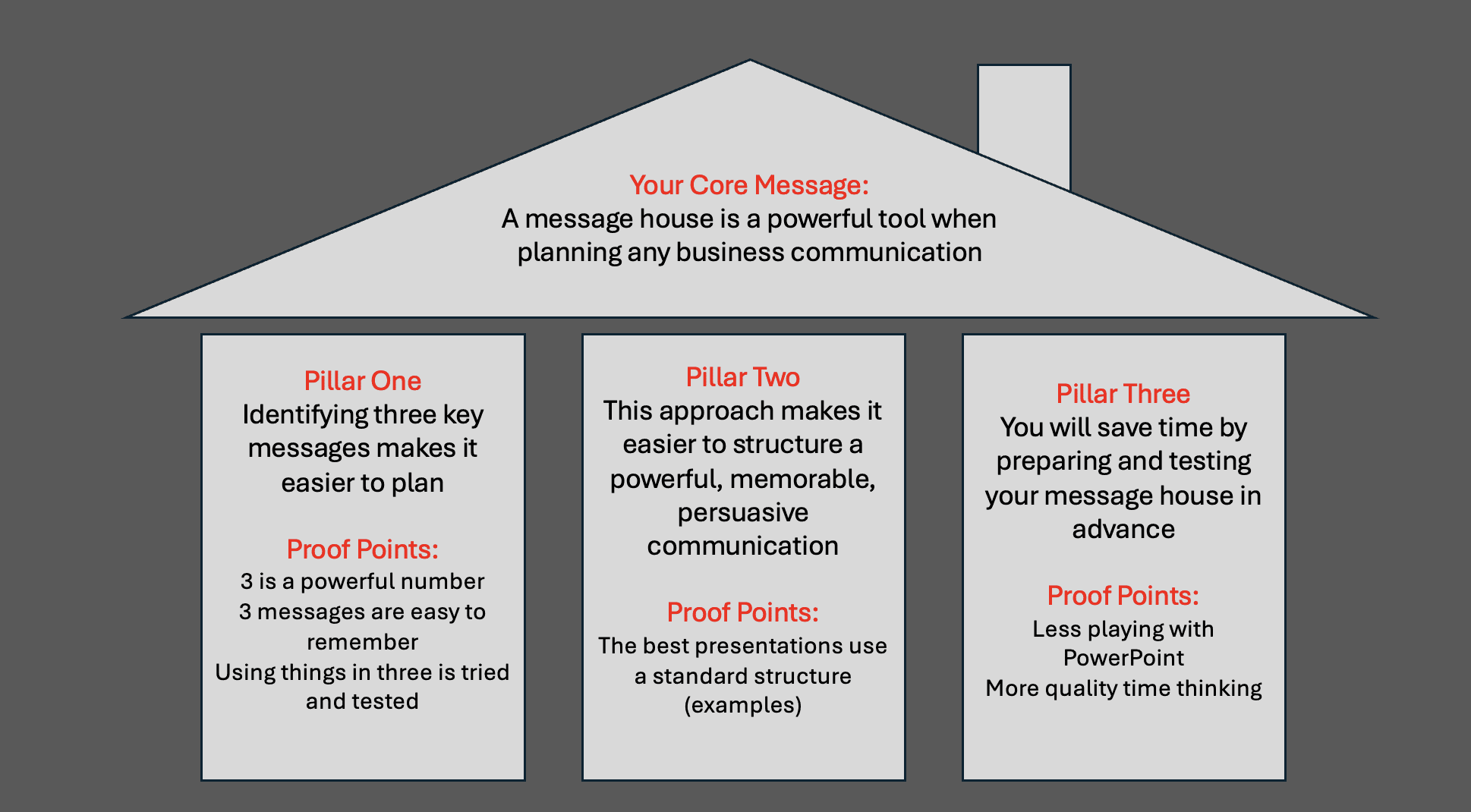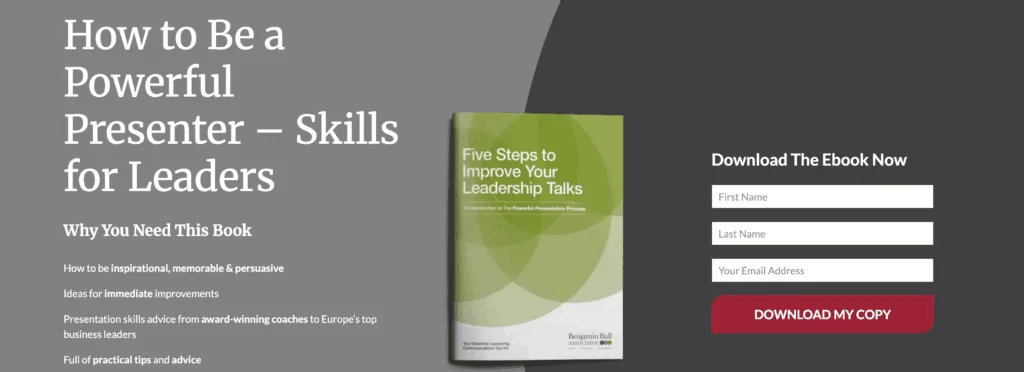
Your Message House Template: And How to Use It
December 06, 2024
What is a message house? How do you use a message house in business communication? What does a message house template look like? What is an example of a message house?

Meet the Author: Benjamin Ball
Ben is the founder of Benjamin Ball Associates and leads the presentation coaching and pitch deck creation teams. Formerly a corporate financier in the City of London, for 20+ years he’s helped businesses win with better pitches and presentations, particularly investor pitches. He is a regular speaker and a guest lecturer at Columbia Business School and UCL London. Follow Ben on LinkedIn or visit the contact page.
Using a Message House Can Make Your Life Easier
Whether you’re preparing for a business pitch, a client presentation, or a public speaking event, using a Message House can simplify your message and make your presentation more effective. So, next time you’re crafting a presentation, take a few moments to build your own Message House—you’ll be amazed at how much more impressive and impactful your communication will become.
At Benjamin Ball Associates, we use message houses religiously when we prepare our own pitches and presentations, and when we work with clients on preparing compelling investor pitches.
When preparing for a presentation, you will make or break your effectiveness by how clearly and concisely you communicate your message. Whether you’re speaking to a small group or addressing a large audience, delivering a clear, compelling message is crucial. But how do you make sure that your message is impactful and well-structured?
Enter the Message House—a simple yet powerful framework that helps presenters and communicators organise their thoughts, identify key points, and deliver messages that resonate. In this article, we’ll explain what a Message House is, how to use it, and share some examples to help you put this technique into practice.
Why Use A Message House?
A Message House is an essential tool for crafting concise messages that work with different audiences across a variety of contexts. Whether you’re preparing marketing materials, a media interview, or an internal presentation, the Message House framework makes sure that your core messages are structured in a way that communicates the overarching message clearly and effectively.
The concept behind a Message House is simple: it helps you identify what matters most by breaking down your communication into a clear, logical structure. The roof represents the umbrella statement—your value proposition or the key takeaway you want the audience to remember.
Beneath that, the pillars represent the value pillars or the supporting points that reinforce your main idea, and at the foundation of the house, you place the proof points—real-world examples, research, or data that validate your main messages.
How Does a Message House Work?
The Message House method is a powerful technique for structuring your thoughts and ensuring your communication is both impressive and impactful. Whether you’re preparing an internal document, refining your brand identity, or prepping for a media interview, the Message House approach can help you deliver a message that is as effective as it is memorable.
A Message House is a strategic communication tool that structures your key messages in a way that’s easy for both the presenter and the audience to follow. It’s often used in business presentations, public relations, marketing, and media communications so that that your message is clear, consistent, and memorable.
Core Elements of a Message House
The basic structure of a Message House looks like this:
- Roof (Your Core Message): The single, clear statement you want your audience to take away.
- Pillars (Supporting Messages): The key points or themes that support and reinforce the core message.
- Foundation (Evidence or Proof): Data, facts, examples, or stories that provide credibility and support the pillars.
In essence, the Message House helps you communicate a complex idea in a simple and structured way. It keeps your communication on track by ensuring that all your points tie back to the central message.
How to Use a Message House in Your Presentation
Your Message House Template
1. Define Your Core Message (The Roof)
Start by identifying the core message—the single, overarching idea that you want your audience to remember. This should be clear and concise. The core message serves as the foundation of your presentation, and everything you say should point back to it.
Core Message Example:
If you are giving a presentation on a new marketing strategy for your business, your core message might be:
- “Our new marketing strategy will help us reach a younger demographic and increase engagement by 20%.”
This is clear and specific, and it provides a red thread for the rest of your presentation.
2. Develop Supporting Messages (The Pillars)
Next, think about the key points that support your core message. These will be the main ideas you’ll elaborate on in your presentation. Each pillar should address a different aspect of the core message, offering further explanation or justification.
Example of The Pillars:
For the core message mentioned above, the supporting messages could be:
- Pillar 1: “The strategy includes targeted digital ads on social media platforms, which are more effective at reaching younger audiences.”
- Pillar 2: “We will leverage data analytics to fine-tune our messaging and create maximum impact.”
- Pillar 3: “Our team will collaborate with influencers to build credibility and drive engagement.”
These pillars should be distinct, but connected to the core message. They provide the substance of your presentation and give the audience a reason to believe in your main idea.
3. Provide Evidence or Proof (The Foundation)
The foundation of the Message House is where you add credibility to your message by providing evidence, data, or examples that back up your supporting points. This could include case studies, statistics, research findings, or anecdotes. The goal is to make your message more persuasive and trustworthy.
Example of Proof Points:
For the pillars listed above, the evidence might look like this:
- Pillar 1 (Digital Ads): “According to a recent study, 80% of individuals aged 18-24 engage more with ads on social media than on traditional TV.”
- Pillar 2 (Data Analytics): “Our data shows that campaigns using targeted analytics saw a 15% higher ROI in 2023.”
- Pillar 3 (Influencers): “In our pilot test, influencer partnerships resulted in a 30% increase in website traffic and a 25% boost in conversion rates.”
This evidence supports the pillars and makes your core message more compelling by demonstrating real-world relevance and credibility.
Benefits of Using a Message House
Using a Message House has several benefits, especially when it comes to improving your presentations:
- Increases Clarity: The framework helps simplify complex ideas into a clear, concise structure. This reduces the risk of overwhelming your audience with too much information.
- Improves Consistency: It makes sure that all parts of your presentation support your central message, avoiding tangents or conflicting information.
- Helps the Audience: By clearly defining the core message and supporting pillars, you’ll stay focused and avoid deviating from the main point.
- Makes Presenting Easier: With well-organised content, your audience is more likely to stay engaged and remember your message.
Tips for Building a Message House
- Keep it simple: Limit your core message to one sentence. This should be the main takeaway you want your audience to remember.
- Be strategic with your pillars: Choose 2-3 key points (ideally three) that reinforce your message. Too many pillars will confuse the audience.
- Provide relevant evidence: Use data, stories, or examples that resonate with your audience.
- Stay flexible: While the Message House structure is powerful, it’s important to adapt it to the specific needs of your presentation and audience. Don’t feel like you need to rigidly follow the format if it doesn’t suit the situation.
An effective messaging house goes beyond just marketing; it’s a useful tool for aligning internal stakeholders and ensuring that everyone from media interviews to internal documents communicates the big picture.
Common Mistakes to Avoid When Creating a Message House
Creating a communication house isn’t always straightforward, and many organisations fall into avoidable traps:
1. One common mistake is skipping the foundational work of defining a clear overarching message. The roof of your messaging house represents the central idea or value you want to convey, and without a strong roof, the entire structure can collapse. Some teams rush into drafting supporting messages without agreeing on the main theme, leading to disjointed communication that confuses the audience. Invest the time upfront so that your roof is solid and relevant.
2. Another pitfall is overloading the messaging house template with too much information. While it’s tempting to cram in every detail, this defeats the purpose of simplicity and focus. A well-designed communication house prioritises clarity, so stick to the essentials. Too many messages can dilute the impact and make it harder for your team to remember and use them effectively.
3. Inconsistent language across different parts of the messaging house is also a frequent error. Your audience’s trust depends on consistency, so ensure that every pillar and supporting statement aligns with the roof. Avoid using jargon or overly complex phrases—simplicity is key to making your message memorable and engaging.
4. Finally, neglecting to revisit and update the messaging house over time can render it ineffective. Markets and priorities evolve, and so should your communication house. Schedule regular reviews so that your messages remain aligned with your audience’s needs and your organisation’s goals.
By avoiding these common mistakes, you can create a messaging house that becomes a powerful asset for your organisation. Start with a clear messaging house template, stay focused, and revisit your structure as needed to keep your communication sharp and impactful.
Speak to an expert. Get a free consultation

Message House Examples
Let’s say you’re giving a presentation on the importance of sustainability in your company’s supply chain.
- Core Message (Roof): “Adopting sustainable supply chain practices will reduce costs and improve our brand image.”
- Supporting Messages (Pillars):
- Pillar 1: “Sustainable practices, such as using eco-friendly materials, lead to long-term cost savings.”
- Pillar 2: “Consumers are increasingly prioritising sustainability, and our brand can attract more customers by committing to these practices.”
- Pillar 3: “Our company can gain a competitive edge by adopting industry-leading sustainability standards.”
- Evidence (Foundation):
- Pillar 1: “In a recent survey, companies that adopted green supply chain practices reported a 12% reduction in operational costs.”
- Pillar 2: “Research by Nielsen shows that 66% of consumers are willing to pay more for sustainable products.”
- Pillar 3: “Leading competitors in the market have already gained a 15% market share advantage by promoting their sustainability efforts.”
In this example, the audience can quickly understand the key message, supporting arguments, and the evidence that validates your points. It makes your argument clear and persuasive.
Further Example of a Message House
For instance, if you’re launching a new product or a new campaign, the Message House can help you align your messaging house with the target audience’s needs. A good example might be a sales team preparing for a product launch presentation.
- Core Message (Roof): “Our new product is designed to simplify everyday tasks for our customers, offering unique functionality and long-term value.”
- Supporting Messages (Pillars):
- Pillar 1: “The product streamlines daily workflows, saving time and reducing stress.”
- Pillar 2: “It offers innovative features that our competitors don’t have.”
- Pillar 3: “Our extensive award-winning research shows that users who adopt the product see a 25% increase in productivity.”
- Evidence (Foundation):
- The proof points here might include award-winning research and customer testimonials.
This simple, structured approach helps check that everyone—from the marketing team to the sales teams—is delivering a consistent message about the product’s benefits.
Start Using Powerful Messages in Your Presentations
A Message House is a powerful communication tool that helps you structure your presentations in a way that makes your message clear, concise, and convincing. By identifying one central idea, supporting it with strong key points, and backing it up with credible evidence, you can ensure that your message is not only heard but remembered.
If your really want to improve your presentation skills and your public speaking skills, then book onto one of our public speaking skills training courses.
Our training courses are fast, effective and will equip you with all the tools to create and deliver powerful business communications.
Speak to an expert. Get a free consultation
Why Choose Us:
Transform your pitches and presentations with tailored coaching

We can help you present brilliantly. Thousands of people have benefitted from our tailored in-house coaching and advice – and we can help you too.
“I honestly thought it was the most valuable 3 hours I’ve spent with anyone in a long time.”
Mick May, CEO, Blue Sky
For 15+ years we’ve been the trusted choice for leading businesses and executives throughout the UK, Europe and the Middle East. We’ll help you improve corporate presentations through presentation coaching, public speaking training and expert advice on pitching to investors.
Some recent clients

Unlock your full potential and take your presentations to the next level.
Speak to Louise on +44 20 7018 0922 or email info@benjaminball.com to transform your speeches, pitches and presentations.
Speak to an expert. Get a free consultation
Frequently Asked Questions (FAQs)
1. What Are the Key Differences Between a Message House and a Messaging Matrix?
A message house organises messages under a central theme, which includes a single overarching idea (the roof) supported by key pillars and details. In contrast, a messaging matrix maps messages across different audience segments, channels, or products, providing a more detailed view of tailored communication strategies.
While a messaging house means consistency and alignment, a messaging matrix enables you to customise for varied contexts.
2. What Tools Can Be Used to Create a Message House?
There are various tools available for creating a messaging house. Common choices include collaborative platforms like Microsoft PowerPoint, Google Slides, or Miro, which allow you to visually structure the house.
For more advanced design needs, tools like Adobe Illustrator or Canva can help create professional templates. Simpler options like Word or Excel work well for outlining the structure.
But remember, the most important part of creating a messaging house is the hard thinking to get your messages right. We regularly help our clients create message houses with a Messaging Cracker Session.
3. How Often Should a Message House Be Updated?
A messaging house should be reviewed and updated regularly to stay relevant.
BUT, the whole point of a messaging house is that is evolves slowly. You should check it regularly, but aim for fewer rather than more changes.
Contact us now for free consultation
Start improving your pitches and presentations now
Contact us now and speak to an expert about getting award-winning coaching, training and advice
